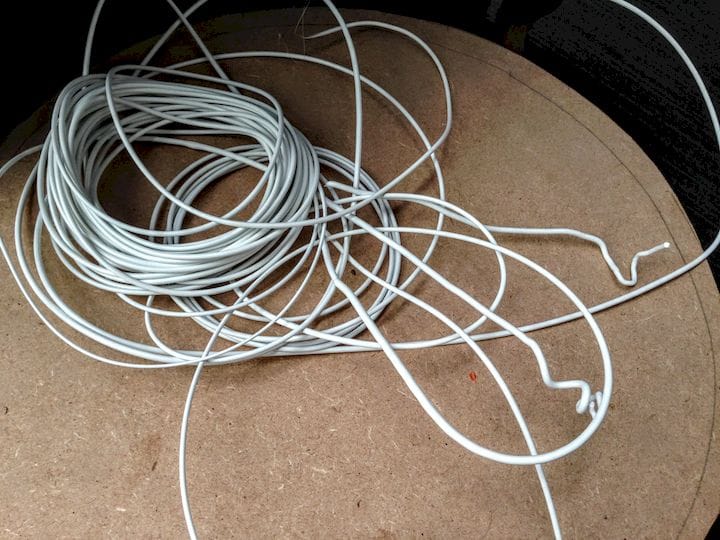![3D printer filament poorly extruded from a desktop device not equipped with a take-up spool [Source: Fabbaloo]](https://fabbaloo.com/wp-content/uploads/2020/05/image-asset_img_5eb0a065e2ed8.jpg)
Over the years there have been several desktop 3D printer filament extruders, and almost all have failed.
These are devices that can take input thermoplastic, perhaps scraps from leftover prints, or maybe pristine thermoplastic pellets from a chemical factory, and extrude them into a filament for use in a 3D printer. The idea is to either save money, or produce custom filaments that are unobtainable otherwise.
Why do startups offering such equipment typically fail? I think there are several reasons for the general lack of success of these products, some technical, and some related to the business model.
Today we find very few such devices on the market, and they don’t seem to be in widespread use. I do recall seeing many startups selling filament extruders at 3D printing trade shows, but more often than not they don’t appear at subsequent shows.
Here are some thoughts on why desktop filament producers may not be successful.
Quality
The 3D printing market is now accustomed to very high-quality filaments. Long gone are the days where you could grab a spool of “welding wire” from the local hardware shop and be satisfied. Today’s premier filaments are carefully crafted by professional plastics manufacturers that employ multiple forms of instrumentation to ensure the highest quality of filament.
Quality means high consistency in three areas:
-
Chemistry, meaning the exact chemical composition of the material to ensure identical results with the same print parameters
-
Coloration, where prints have the same color from batch to batch
-
Dimensionality, where the diameter and roundness of the filament is within an extremely tight range, usually less than 0.05mm.
Professional manufacturers with modern equipment lines and sophisticated supply chains can do this. Their multiple laser measurement systems, 10m slow-cooling tanks and precision drying systems work in concert to produce volumes of consistent, high-quality filament.
Almost without exception, desktop filament extruders do none of this. There is virtually no way a desktop unit can produce quality filament to match that coming from professional manufacturers.
Ignorance of Entire Workflow
All too many desktop filament extruders ignore the immediately obvious problem of capturing the filament. I’ve literally seen devices simply spill new filament on the floor, and had no idea how you could possibly make any practical use of the knotted pile of filament produced.
Any desktop 3D printer filament extrusion system must include a take-up mechanism to properly spool the produced filament.
Convenience
Buying a spool of high-quality filament from a professional provider is easy: just select a quality and click “Buy Now”. But producing your own filament inolves many more steps, including purchasing industrial thermoplastic pellets, which are typically sold by the pallet. Would you like to accept delivery of a pallet of pellets? I didn’t think so.
And there’s the problem of coloration, if that’s required. A masterbatch of color dye must be selected, purchased and mixed with precision to obtain the desired filament output color.
Materials
The choice of materials for use in desktop 3D printer filament extruders is often limited in that the machines typically have lower temperatures. Today’s professional 3D printer users increasingly demand higher-temperature materials like nylons, PEEK, PAEK, ULTEM, etc. These are typically not producible on desktop equipment.
Reliance On EcoAffinity
Several filament extruder ventures we have seen rely on the notion of recyclability. This is extraordinarily difficult to achieve, simply because the recycled material found will vary in chemistry, material type, color and quality. It could also be contaminated with who knows what?
In practice, any plastics recycling operation has relied on selecting ONE type of branded material (e.g., empty Pepsi bottles known to be made from one type of PET material), and thus little recycling impact actually occurs. This is rarely pointed out to buyers, who mistakenly believe they are saving the planet by buying such devices.
Business Model
The two standard business models one often sees are “sell a small number of units at high prices”, or “sell a large number of units at low price”. Due to the above reasons, it’s clear that there would never be a large number of units sold. But at the same time the simplicity of the device (it’s just an extruder), means competition can quickly drive the price to the bottom.
This means that this space is largely condemned to “sell a small number of units at low prices”. That is not a recipe for business success.
Unless the folks behind these ventures can find a way to raise their revenue by adding features, raising quality or volume, they likely won’t be tremendously successful.
Another business model challenge is that the users most likely to take advantage of the product’s ability to produce inexpensive filament are those companies that would consume large amounts of filament. But they would typically be large enough to demand rock-bottom volume-discounted prices from professional manufacturers. They’d also require the quality and consistency of professional products. Thus this kind of product is left to casual users.
If you’re shopping for a 3D printer filament extruder of your own, consider these characteristics when examining a product option.
For me the bottom line is to simply continue to buy filament from professional manufacturers. Over time they will both reduce pricing due to competition – yet maintain product quality, and introduce new material variants.











No one seems to offer collaborative 3D printing modes on dual extrusion devices. We explain why this is the case.